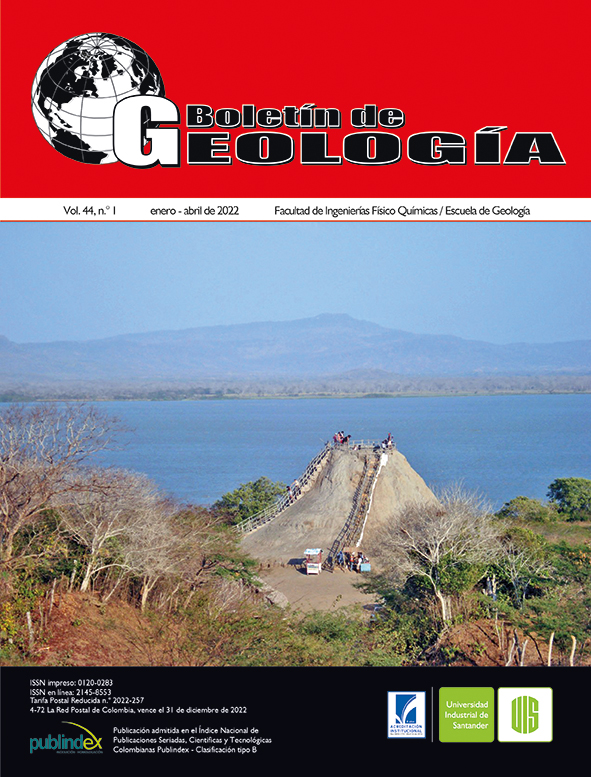Published 2022-01-25
Keywords
- Source rock reservoirs,
- Shale,
- Digital petrophysics,
- Digital rock physics
How to Cite
Copyright (c) 2022 Boletín de Geología

This work is licensed under a Creative Commons Attribution 4.0 International License.
Altmetrics
Abstract
Unconventional deposits (source rock reservoirs) represent a new stage in the exploration and exploitation of oil and gas worldwide, and their petrophysical characterization continues to be a challenge due to low permeabilities, high levels of heterogeneity, and the difficulty of adapting conventional techniques. Digital petrophysics emerges as an alternative that takes advantage of the latest advances in electron microscopy, computed tomography, and computational processing to estimate petrophysical properties using numerical methods and voxel counting algorithms in what is called a digital rock model. This work carries out a review of digital characterization techniques and their application to unconventional reservoir samples belonging to the Vaca Muerta Formation (Argentina) and La Luna Formation (Colombia). With this technology, it is possible to visualize the porous space on a micro and nanometric scale to obtain qualitative information (types of pores and microfractures) and quantitative information (porosity, absolute permeability, pore size distribution, organic matter content, and advanced petrophysical properties). The results obtained indicate that the FIB-SEM samples are below the representative elementary volume and that digital samples with larger dimensions, although more representative, require greater computational capacity. The upscaling of petrophysical properties, the lack of connectivity of the porous medium, and the poor representativeness are the most important limitations of using this technology. However, its potential increases as artificial intelligence, simulation, and machine learning techniques gain strength in the oil and gas industry.
Downloads
References
- Al-Amri, S.S.; Kalyankar, N.V.; Khamitkar, S.D. (2010). Image segmentation by using threshold techniques. Journal of Computing, 2(5).
- Andrew, M. (2019). Vaca Muerta FIB-SEM. www.digitalrocksportal.org
- Cantisano, M.T.; Restrepo, D.P.; Cespedes, S.; Toelke, J.; Grader, A.; Suhrer, M.; Walls, J. (2013). Relative permeability in a shale formation in Colombia using digital rock physics. Unconventional Resources Technology Conference. Denver, Colorado. https://doi.org/10.1190/urtec2013-092
- Chorin, A.J. (1967). A numerical method for solving incompressible viscous flow problems. Journal of Computational Physics, 2(1), 12-26. https://doi.org/10.1016/0021-9991(67)90037-X
- Dvorkin, J.; Derzhi, N.; Fang, Q.; Nur, A., Nur, B.; Grader, A.; Baldwin, C.; Tono, H.; Diaz, E. (2009). From micro to reservoir scale: Permeability from digital experiments. The Leading Edge, 28(12), 1446-1452. https://doi.org/10.1190/1.3272699
- Giannuzzi, L.A. (2004). Introduction to focused ion beams: instrumentation, theory, techniques and practice. Springer Science & Business Media.
- Jiao, L.; Andersen, P.Ø.; Zhou, J.; Cai, J. (2020). Applications of mercury intrusion capillary pressure for pore structures: A review. Capillarity, 3(4), 62-74. https://doi.org/10.46690/capi.2020.04.02
- Klaver, J.; Desbois, G.; Urai, J.; Littke, R. (2012). BIB-SEM study of the pore space morphology in early mature Posidonia Shale from the Hils area, Germany. International Journal of Coal Geology, 103, 12-25. https://doi.org/10.1016/j.coal.2012.06.012
- Lemaitre, J.; Troadec, J.P.; Bideau, D.; Gervois, A.; Bougault, E. (1988). The formation factor of the pore space of binary mixtures of spheres. Journal of Physics D: Applied Physics, 21(11), 1589-1592. https://doi.org/10.1088/0022-3727/21/11/007
- Levner, I.; Zhang, H. (2007). Classification-driven watershed segmentation. IEEE Transactions on Image Processing, 16(5), 1437-1445. https://doi.org/10.1109/TIP.2007.894239
- Li, C.; Wang, D.; Kong, L. (2021). Application of machine learning techniques in mineral classification for scanning electron microscopy-energy dispersive X-Ray spectroscopy (SEM-EDS) Images. Journal of Petroleum Science and Engineering, 200. https://doi.org/10.1016/j.petrol.2020.108178
- Lin, C.L.; Miller, J.D.; Hsieh, C.H.; Tiwari, P.; Deo, M.D. (2010). Pore scale analysis of oil shale pyrolysis by X-ray CT and LB simulation. 6th World Congress on Industrial Process Tomography. Beijing, China.
- McLean, R.; Miller, C.; Guzman, B.; Walls, J. (2017). Quantifying organic porosity and predicting estimated ultimate recovery (EUR) in the Eagle Ford Formation. Unconventional Resources Technology Conference. Austin, Texas.
- Nozad, I.; Carbonell, R.G.; Whitaker, S. (1985). Heat conduction in multiphase systems˗I: theory and experiment for two-phase systems. Chemical Engineering Science, 40(5), 843-855. https://doi.org/10.1016/0009-2509(85)85037-5
- Saif, T.; Lin, Q.; Bijeljic, B.; Blunt, M. (2017). Microstructural imaging and characterization of oil shale before and after pyrolysis. Fuel, 197, 562-574. https://doi.org/10.1016/j.fuel.2017.02.030
- van Milligen, B.P.; Bons, P.D.; Carreras, B.A.; Sanchez, R. (2005). On the applicability of Fick’s law to diffusion in inhomogeneous systems. European Journal of Physics, 26(5), 913-925. https://doi.org/10.1088/0143-0807/26/5/023
- Wellington, S.L.; Vinegar, H.J. (1987). X-ray computerized tomography. Journal of Petroleum Technology, 39(08), 885-898. https://doi.org/10.2118/16983-PA
- Zhang, L.; Jing, W.; Yang, Y.; Yang, H.; Guo, Y.; Sun, H.; Zhao, J.; Yao, J. (2019). The investigation of permeability calculation using digital core simulation technology. Energies, 12(17). https://doi.org/10.3390/en12173273
- Zoback, M.D.; Kohli, A.H. (2019). Unconventional Reservoir Geomechanics. Cambridge University Press.

